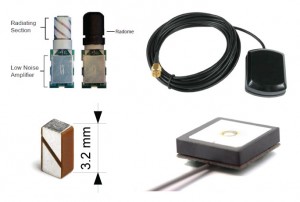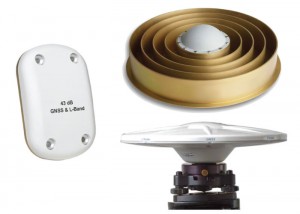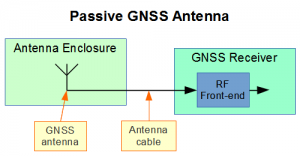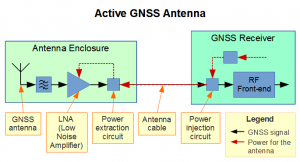Depending on application (or price) a GNSS antenna may be a quite complicated device. The GNSS receiver performance may suffer significantly if the antenna is connected incorrectly or if the antenna is of a lower class than the receiver.
In this brief article I will try to point to a few important points about GNSS antennas that hopefully will be useful for someone who is just entering the GNSS world.
The Classes of GNSS Antennas
The antenna class definition may vary depending on your background and GNSS application field. In general GNSS antennas belong to one of the two classes – consumer class and professional class. Antennas from each of them can have different shapes, sizes and types of mounting. But it is the antenna design and implementation quality that make the difference. Very often a smaller antenna size means lower antenna performance as the antenna will have more compromises. But each antenna market puts its own emphasis on which antenna technical parameters, size or price are the most important factors.
Consumer Class Antennas
Consumer class antennas are usually more compact as the size plays an important role for this user segment. Most of them are strictly single frequency antennas made to receive only GPS signals. More and more of today’s consumer GNSS antennas can receive at two frequencies – GPS L1 and GLONASS L1. The two GNSS frequencies are not too far away from each other, but cheap GPS-GONASS antennas may have some additional compromises comparing to GPS only antennas.
Any GPS antenna should be able to receive Galileo E1 (L1) signals without any significant issues for most of consumer applications.
Some antennas in this class are combined into one unit with antennas for mobile or satellite communication.
The same type antennas, but in a more rugged implementation can be used for more demanding applications like airplanes, boats, etc. However in the industrial, business markets these applications use even higher performance antennas.
Professional Class Antennas
Professional class antennas are used together with professional class GNSS receivers. This combination enables to archive mm to cm level precision depending on the application field (this requires RTK or DGPS solutions). These antennas are typically multi-system and multi-frequency antennas (at minimum GPS L1 and L2). Professional class antennas have well controlled and precisely measured phase center which in combination with so called phase measurements in the GNSS receiver enables to archive the highest possible measurement precision.
Professional applications often depend on products with well defined and verified GNSS equipment performance and behavior. Some applications require safety certification etc. Therefore the professional GNSS equipment price can be 10 or 100 times higher than in the consumer class, even when at the first glance the standalone measurement precision may appear to be equivalent to the consumer class.
Connecting a GNSS Antenna
Many antennas in GNSS and other radio applications are passive devices that capture radio signals and then pass it through a 50 Ω impedance cable to the receiver. A simplified diagram in the figure bellow shows how such antenna is connected. As the GNSS signals are very week (at about -130 dBm) often one of the first components in the receiver RF (Radio Frequency) front-end is an LNA. LNA stands for Low Noise Amplifier. It is a high performance amplifier where the performance comes at the price of power consumption. Some receivers need an external LNA for proper operation.
The antenna cable attenuates the already very week GNSS signals. Several meters of a cable can significantly attenuate the received GNSS signal (the attenuation is cable quality dependent). Therefore many GNSS antennas have an LNA (together with filters) as close as possible to the antenna, often inside of the antenna enclosure. Such antennas are called active antennas.
These antennas need a power source for the LNA operation. DC power is supplied by the receiver through the ordinary antenna cable with help of additional electronic circuits on the receiver and antenna sides. This type of power for active antennas is sometimes called phantom power.
Most commonly used GNSS antennas today need from 3 to 5 volts phantom power. The older design antennas may operate only when the voltage is not less than 5 V. Some of consumer antennas support as low as 1.8 V. The more special antennas may support (or GNSS receivers may provide) as high as 12 V or 24 V voltages. Therefore always consult the receiver and antenna documentation for the nominal and maximum voltages for antenna phantom power. Exceeding the maximum antenna voltage may damage the antenna. Too low voltage can cause insufficient GNSS signal levels and unstable receiver positioning performance.
Some of the antennas due to intended or unintended design may have antenna amplifiers where the amplification depends on the voltage of antenna power. For example an antenna that supports voltages from 2 to 5 volts may provide amplification in range from 22 dB to 31 dB. This can cause a problem to a receiver that depends on a 30 dB amplification in the antenna but it provides only 2 V power for the antenna.
Too much of signal amplification can cause problems as the interference levels may reach unacceptable levels. Most often the receiver or receiver front-end documentation will specify what external signal amplification level is required.
Very Special GNSS Antennas
Apart of the mentioned above antennas there are more GNSS antennas made for special applications:
- Antenna arrays (more specifically – phased arrays) employ beamforming algorithms to dynamically control the combined antenna signal reception pattern in such a way that effective radiation pattern of the array is reinforced in a desired direction and suppressed in undesired directions. In most cases these antennas are used to avoid reception of interfering signals.
- A combination of 2 antennas is used to measure direction for example in ships or agriculture applications. In maritime applications such devices are called satellite compasses.
A combination of 3 to 4 antennas are used to measure attitude of planes, space vehicles, ships, trucks, buildings and other structures.
The two mentioned cases require dedicated GNSS receivers or in some cases – a set of receivers arranged to work closely together.





Hi Darius. Do you know any reference where I can find more detailed design of the power extraction circuit in active antenna?
Hi,
No, I do not have any references on this topic as my background is mostly software development. I could imagine that it is a fairly common topic in the field of radio engineering.
Hello Darius,
Any thoughts on what might be the best of light weight gps antennas for use as a downed drone locator? The downed drone may find itself at any attitude including partially burried in the earth. Obviously, therefore, antennas should be as close to omnidirectional as possible. I have also been wondering if there would be great problems with using two gps receivers (antennas) at different attitudes to increase chances of ‘looking’ at the sky. The idea is to determne downed drone’s position and realay it by Xbee to home. Obviously weight is a major consideration. I’ve been looking at Sarantel’s Geo Helix Quadrafilar type antenna but they are hard to find here in the US.
Regards, Joe Homer
Hello Joe Homer,
My info on GNSS antennas marrket is outdated and incomplete. Yes you could use two GNSS antennas and two receivers. This could have a negative impact on power consumption and also as you noted – the weight and size. You could investigate the posibility to use two antennas and a single receiver. In this case you need a good quality RF switch. Some GNSS receiver chipset do contain such switch that normally is used for other purposes. But I do not know if any GNSS receiver module has such functionality exposed to the “end user” so it could be easily exploited for your goals.
Also you might consider a diplole antenna installed along one of the long edges of the drone’s fuselage (airframe). It’s not a perfect solution but it might the best compromise in your case. In this case you would loose about 3dB of the received signal power due to use of a non-circular polarization antenna.